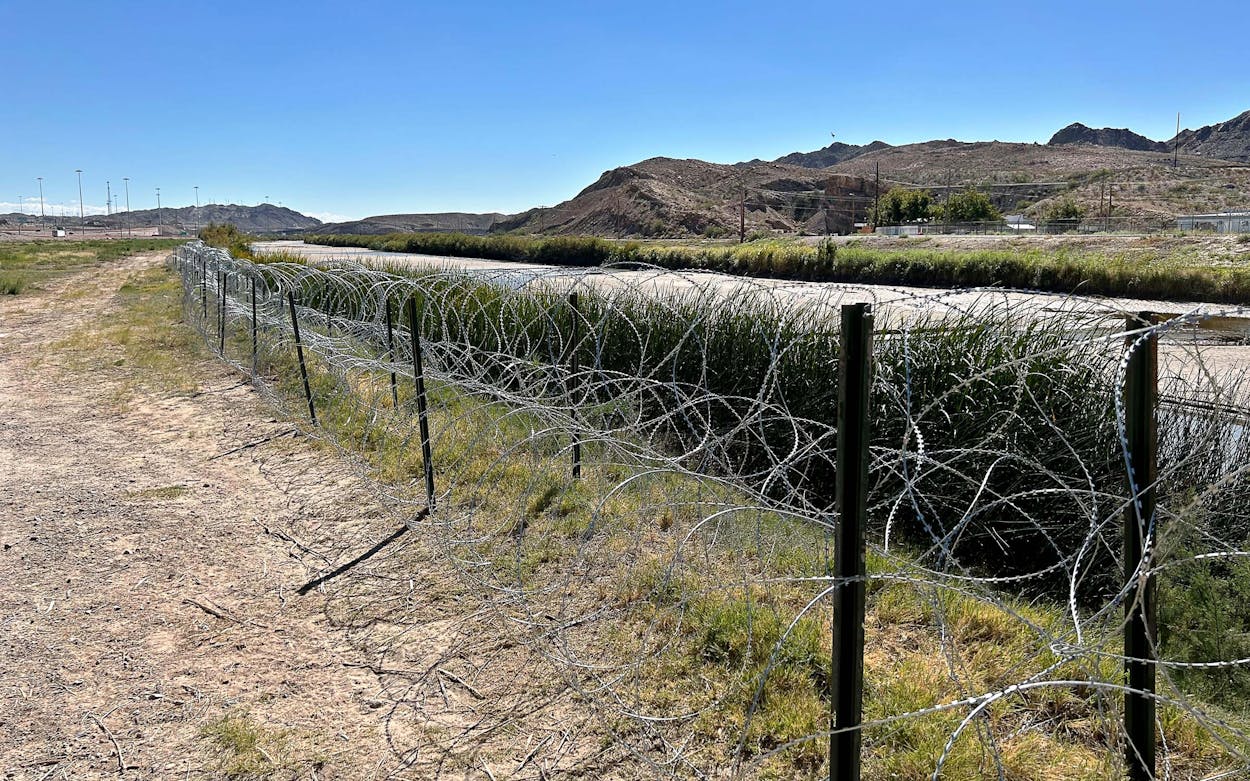If you’re making the short drive from El Paso to neighboring Sunland Park, the only indication you’d have that you’re crossing state lines is an announcement by GPS that sounds shortly after you cross the Anapra Bridge over the Rio Grande: “Welcome to New Mexico.” This is the same bridge beneath which, earlier this month, coils of concertina wire appeared, extending a couple of miles southeast along the Texas–New Mexico border. The new barrier was Texas governor Greg Abbott’s latest bit of theater intended to draw attention to migrant crossings into the Lone Star State. “Migrants are entering New Mexico illegally then crossing into Texas,” Abbott wrote on X, formerly known as Twitter, accompanying a photo of the Texas National Guard unfurling the wire, like a big Slinky toy with razor teeth. “We are stopping it.” Denizens of the New Mexican town of 17,000—no strangers to migrant traffic—found that hard to believe.
Robert Ardovino, who lives in El Paso but runs a restaurant in Sunland Park, was commuting to work one morning in early October when he first noticed the wire. He remembered chuckling: “That’s a big old waste of money,” Ardovino said. What really tickled him was that the Texas state line at this point extends across the far western bank of the Rio Grande; evidently, in laying the barrier on the eastern side, the governor had gotten his state line wrong. “My first thought was, ‘Man, that son of a bitch is barricading Texas from Texas,’ ” he recalled.
Ardovino doesn’t need to be told that Sunland Park is an axis for illegal immigration. He named his restaurant Ardovino’s Desert Crossing both as an homage to Cormac McCarthy’s novel The Crossing and because it’s a frequent and popular transit point for migrants—and always has been.
The restaurant sits alongside a fledgling RV park populated by vintage trailers on a hill. The property offers a panoramic view of Sunland Park and its outskirts, including the border wall. On a recent afternoon, Ardovino pointed southeast toward the nearby Sierra de los Muleros—Spanish for “mule drivers’ mountain”—and noted the intricate network of footpaths, like scars in the hill, which straddles both sides of the border. “If there were cattle, you’d understand all the millions of trails through there, but there’s none,” he said. “These are all migrant trails. You go for a hike up there and follow any trail you want. They all lead to Mexico.”
Along the perimeter of his property, Ardovino erected a chain-link fence with razor wire on top last year, which set him back around $15,000. In the service and hospitality industries, immigration enforcement isn’t exactly good for business. “The first time a Border Patrol agent runs chasing someone into the dining room, I might as well just close the doors,” he said.
As we stood out on his property’s veranda, Ardovino suddenly pointed in the distance toward the desert basin: “Two migrants just ran right through there,” he said. Several minutes later, Ardovino’s dogs started barking, and I noticed a man, no more than a hundred yards from us, sprinting with his phone in hand. He stopped before a dirt road and ducked behind a mesquite bush, then charged forward again, crossing the path. “Guess he might get away,” Ardovino said. Just as soon as he’d uttered it, a Border Patrol truck came barreling down the dirt road, turning onto the one that the migrant had just crossed. The man had seemingly disappeared.

Sunland Park, perhaps best known for its casino and racetrack, has seen its fair share of physical infrastructure crop up in the name of border security. George W. Bush built a wall near town, which Trump refurbished. In 2019, a group of civilians, led by former Trump adviser Steve Bannon, got in on the fray and started erecting a wall, before city officials stopped them. (Bannon was later indicted on federal mail-fraud charges for some of his private-wall-building activities, but was pardoned by Trump before his trial.) This latest move in Abbott’s controversial Operation Lone Star, a nearly $10-billion initiative that launched in 2021 ($11 million has been spent on concertina wire alone) is just one more physical barrier. “Until President Biden does his job to secure the border,” Andrew Mahaleris, the governor’s press secretary, wrote in an email, “Texas will continue stepping up to protect our borders and Texans from this crisis.”
A few months ago, officials from Juárez and Sunland Park met to discuss the potential to build a new international port of entry between their two cities. Almost everyone in the area agrees that effective measures are needed to control the flow of migrants into the U.S. “I hate to hear New York complain about five hundred immigrants,” Ardovino said, referring to the migrant crisis in the Big Apple, where more than 100,000 migrants and asylum seekers, including 13,000 that Abbott had bused, have arrived in the last year. It prompted New York City mayor Eric Adams to declare a state of emergency earlier this month. “We’re at fifteen hundred a day.”
In Sunland Park, illegal immigration has become an issue for the community’s younger population—teens who, through social media, are solicited to assist smugglers by shuttling groups of people in vehicles for a hefty price. And it’s not uncommon for migrants to cross into Texas after entering the U.S. through New Mexico. The governor’s team did not provide data on how many migrants do so, but Mary Stillinger, a criminal defense attorney in El Paso, said that of her cases involving illegal entry, approximately half of them involve migrants who crossed the state line. “But here’s the thing,” she said. “They’re coming on the roads. They’re getting picked up in vehicles in New Mexico and then driving over here.” She added, “I’m not sure what Governor Abbott’s going to do about that.”
Folks in Sunland Park aren’t convinced that the barrier works, or that the concertina wire is anything more than a stunt aimed at attracting TV news cameras. No matter how many miles of fence Abbott orders installed along the Texas-Mexico border, how many floating barriers he sets in the Rio Grande, and how many busloads of migrants he sends to northern states, the volume of illegal immigration to Texas continues to increase. Data provided by the U.S. Customs and Border Protection agency shows that in its El Paso sector, which includes western Texas and New Mexico, the number of migrants encountered by agents has more than doubled between 2021 and 2023, to 427,471. Examining Texas’s role alone in this sector, the numbers have gone up from 68,946 in 2021 to 257,643 in 2023. Across the whole southern border, that number has risen from 1.7 million in 2021 to nearly 2.5 million this year. Over the same time period, Texas has unfurled 70,000 rolls of concertina wire on Abbott’s orders.
“Human ingenuity trumps everything,” said Sunland Park fire chief Daniel Medrano, who spent 27 years working for the El Paso Fire Department before assuming his current role. All along the border wall, he said, you’ll find pieces of rope migrants use to scale it. Medrano mentioned he’d also recently seen a video of a young mother using a piece of a cardboard box to lift up a segment of concertina wire so that her kids could crawl underneath. “The problem with the United States is that we are reacting to a problem. We’re putting painkillers on a broken bone. There is a root problem that needs to be addressed.”
If Medrano’s phone rings, it’s often an emergency related to a migrant. This past summer was particularly busy because of the heat, which reached record highs. “We lost track of how many bodies we helped recover,” Medrano said. Last year, Medrano had a different problem in the form of the border wall, where more than a hundred falls occurred. He said he saw a lot of open fractures, where the skin is penetrated by one or more broken bones—particularly femurs, which are surrounded by major arteries that can cause heavy bleeding. He also saw many back and head injuries. Several migrants had died.
Of the latest concertina wire installation, Medrano said he didn’t have any reason to believe it would amount to anything more than one additional obstacle for first responders trying to access the river during water rescues. Not to mention, Medrano said, the wire’s northern end stops before the Anapra Bridge, offering an easy pathway between states. “If I wanted to go around it, it’s very simple to go around it.”
I wanted to see the wire up close, so I drove to a convenience store in Sunland Park, right beside the Rio Grande, and wandered on foot down to the river. As Medrano told me, in so many ways, El Paso and Sunland Park are interconnected. New Mexico controls the flow of water in the Rio Grande here. In late October, it had limited the river’s flow one hundred miles upstream at the Caballo Dam, so the river here in Sunland Park was shrinking, revealing muddy islands and small pools of deeper water. Across the river on the eastern bank, the steel wire gleamed. I wanted to get a closer look and contemplated getting my feet wet to cross the riverbed. Then, I remembered the bridge. I clambered ashore and crossed over: It was as easy as that.
- More About:
- Politics & Policy
- Greg Abbott








